ZEN MESTEREK ZEN MASTERS
« Zen főoldal
« vissza a Terebess Online nyitólapjára
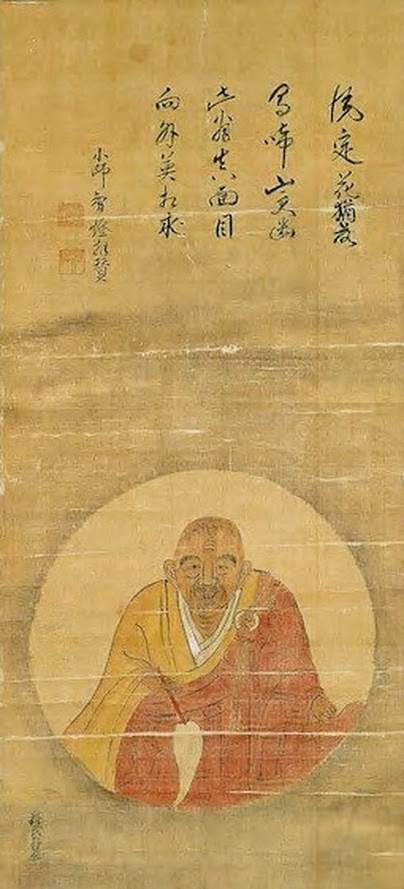
月舟宗胡 Gesshū Sōko (1618-1696)
Tartalom |
Contents |
Szótó Zen mesterek versei: Gesshū Sōko Gesshū Sōko: Búcsúverse Gesshū Sōko: Vers a halál mesgyéjéről |
Poems Death Poem Shōjurin shingi (Rules of Purity for Shōju Grove) Calligraphy by Gesshū Sōko (1618-1696) |
Gesshū Sōko (1618–1696) was a Japanese Zen Buddhist teacher and a member of the Sōtō school of Zen in Japan. He studied under teachers of the lesser known, and more strictly monastic, Obaku School of Zen and contributed to a reformation of Sōtō monastic codes. As a result, he is sometimes given the title "The Revitalizer".
Gesshū Sōko passed Dharma transmission to Zen Master Manzan Dōhaku who went on to restore the strong master-disciple bond in Sōtō Zen.
He is known for his calligraphy as well as his poetry, including his death poem:
1
There is nothing I can say
about what is between
mother and child.Hearing of her death,
my life is darkened.Like a reed basket,
the years wove us together.In the blank air
the smoke from a single incense stick
is my last word with her.(written when he was sixteen, on pilgrimage,
hearing of his mother’s death)
2
Searching for fame and gain
keeps everyone restlessly busy
but in the sun’s warmth
and a peaceful breeze
everything is naturally new.Without help from anyone
the spring’s brightness
is both pale and deep.In the mountains
of boundless peace
someone sits, alone.(at Takugen-ji, Settsu)
3
Under the trees,
welcoming spring.
Things take care of themselves.A monk looks weird
to the common folk.The Teaching of this New Year
is not outside the mind.Filling the eye,
blue, blue mountains
in all directions.
4
Sucking up the boundless sea
exposes the dragon below.The stream of Soto Zen
flows uphill.Awake at last,
I can breathe.
5.
Breathing in, out,
forward, back,
living, dying.Two arrows meet in mid air,
slice and sail on through
into open space.I turn around.
(death poem, Jan. 10, 1696)
Translated by Yasuda Joshu roshi and Anzan Hoshin roshi
Inhale, exhale
Forward, back
Living, dying:
Arrows, let flown each to each
Meet midway and slice
The void in aimless flight—
Thus I return to the sourceTranslated by Yoel Hoffmann
Japanese Death Poems: Written by Zen Monks and Haiku Poets on the Verge of Death. Tuttle Publishing. 1986.
Dharma Lineage
永平道元 Eihei Dōgen (1200-1253)
孤雲懐奘 Koun Ejō (1198-1280)
徹通義介 Tettsū Gikai (1219-1309)
螢山紹瑾 Keizan Jōkin (1268-1325)
明峰素哲 Meihō Sotetsu (1277-1350)
珠巌道珍 Shugan Dōchin (?-1387)
徹山旨廓 Tessan Shikaku (?-1376)
桂巌英昌 Keigan Eishō (1321-1412)
籌山了運 Chuzan Ryōun (1350-1432)
義山等仁 Gisan Tōnin (1386-1462)
紹嶽堅隆 Shōgaku Kenryū (?-1485)
幾年豐隆 Kinen Hōryū (?-1506)
提室智闡 Daishitsu Chisen (1461-1536)
虎溪正淳 Kokei Shōjun (?-1555)
雪窗祐甫 Sessō Yūho (?-1576)
海天玄聚 Kaiten Genju
州山春昌 Shūzan Shunshō (1590-1647)
超山闡越 Chōzan Senetsu (1581-1672)
福州光智 Fukushū Kōchi
明堂雄暾 Meidō Yūton
白峰玄滴 Hakuhō Genteki (1594-1670)
月舟宗胡 Gesshū Sōkō (1618-1696)
卍山道白 Manzan Dōhaku (1635-1715)
Shōjurin shingi (Rules of Purity for Shōju Grove)
in “Rules of Purity” in Japanese Zen
by T. Griffith Foulk
In the Sōtō Zen school, an early example of a reformer influenced by Ōbaku practices is Gesshū Sōko (1618–1696), who trained with Yinyuan and
other Chinese monks in the middle of his career and then went on to become the abbot of Daijōji, an important Sōtō monastery. Inspired by the
Ōbaku shingi and desirous of producing a Sōtō counterpart that could be used to facilitate communal sangha-hall training and hold formal retreats
(kessei) at Daijoji, Gesshū consulted Dōgen’s commentaries on the Chanyuan qingui and Keizan’s Nōshū Tōkokuzan Yōkō zenji gyōji shidai, then
compiled the Shōjurin shinanki (Record of Guidelines for Shōju Grove [Daijōji]), also known as Shōjurin shingi (Rules of Purity for Shōju Grove), in
1674.* In 1678 Gesshū and his disciple Manzan Dōhaku (1636–1715) took the aforementioned set of rules that Keizan had written for Yōkōji and
published them for the first time under the title of Keizan oshō shingi.
* SZ, Shingi, pp. 439–548. The full title of the text is Shōjurin daijō gokoku zenji shingi shinanbo
(Rules of Purity Handbook for Shōju Grove Daijō Nation-Protecting Zen Monastery). Gesshū’s disciple,
Manzan Dōhaku, assisted to such a degree in the compilation that he should be considered a co-author.
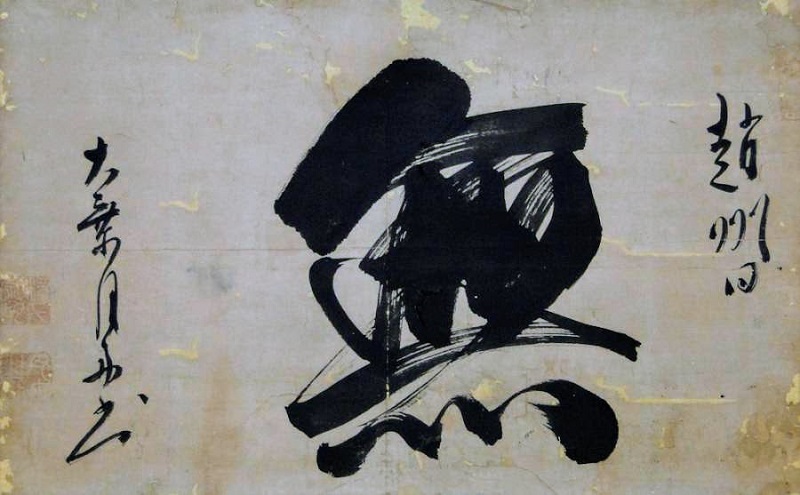
Inscription: 無 Mu.
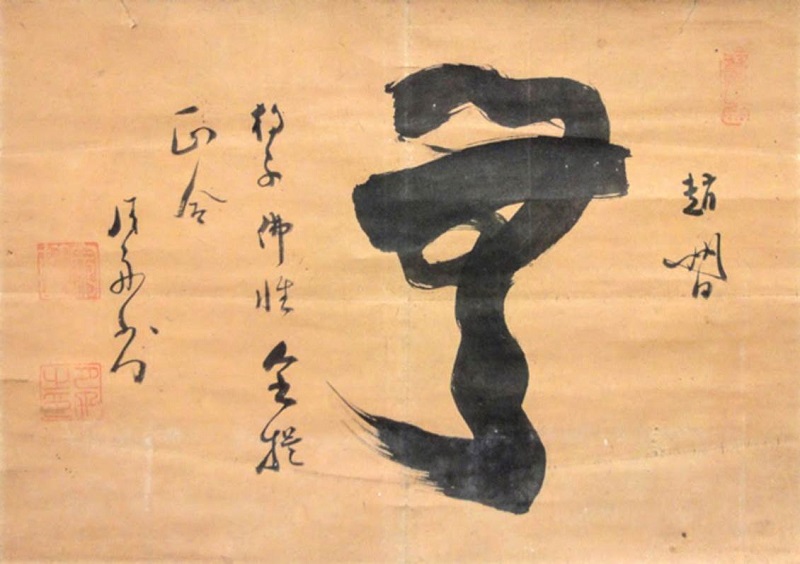
Inscription: 無 Mu.
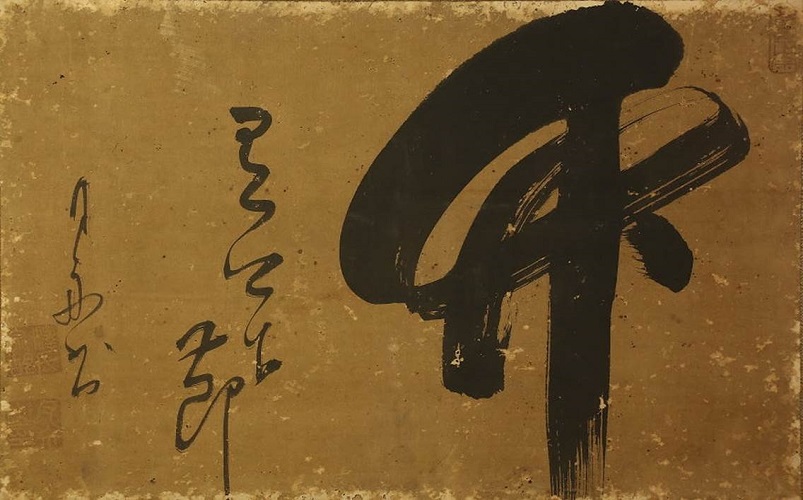
Inscription: 竹有上下節 Bamboo has upper and lower sections.
Gesshū Sōko (1618-1696)
by Stephen Addiss
In: The art of Zen : paintings and calligraphy by Japanese monks, 1600-1925
New York : H.N. Abrams, 1989. pp. 64-69.
Known as the "Restorer of the Sōtō Sect of the Edo Period," Gesshū was born
to the Harada family in Higo (present-day Kumamoto prefecture), not far
from the port city of Nagasaki. At the age of eleven he became a monk at a
temple of the Shingon sect. Perhaps because he was not satisfied with Shin-
gon's esoteric doctrines, the following year he began to practice Zen under the
monk Kagaku at Ennō-ji. At the end of the year he returned home for a short
respite, and his mother overheard him saying to a friend that if he were
granted a large stipend to be lord of the province, he would give up being a
monk to be a nobleman. His mother cautioned him, saying that in the past
emperors had even given up their thrones to become monks. Gesshū later felt
that the diligence of his subsequent training owed much to that chiding; he
returned to Ennū-ji and redoubled his efforts.Gesshū set out on pilgrimage at age sixteen. It was during this period that
he heard his mother had died, and he wrote a poem in her memory:HEARING THE NEWS OF MY MOTHER'S DEATH
There is no way to describe the bond between mother and child—
Hearing of her death, my entire life is darkened.
Over the years we have been woven together like a reed basket;
To the empty sky I answer her spirit with the smoke from one stick of incense.Gesshū studied for a time with Ban'an at Zuigan-ji near Kyoto. There he
struggled over the meaning of the phrase mushin ("without heart or mind"):
Was the human spirit to be as empty as a tree or a rock? One day he came
across the phrase "When you arrive at mushin you can see your own nature."
Gesshū pondered this day and night and achieved his first awakening:Sitting in an outhouse, I concentrated upon this doubt, and as time passed I forgot to
leave. Suddenly a violent wind came, first blowing the outhouse door open and then shut
again with a loud crash. My spirit instantly advanced and ripped apart my previous
doubt; it was like suddenly awakening from a dream, or remembering something
forgotten. I began to dance in a way I had never learned, and there are no words to convey
my great joy.This first awakening, however, was not recognized by Ban' an, and several
years later Gesshū had another and greater enlightenment, based upon pierc-
ing the great obstacle Mu. This time, his satori was acknowledged.Gesshū then settled at the important historical Sōtō temple Daijō-ji in Kaga
(Ishikawa prefecture) to practice under Hakuhō Genteki. At the age of thirty-
one Gesshū received inka from Hakuhō, but he still wished to continue his
Zen studies. He returned to Kyushu to visit his former teacher Kagaku in
Hizen and later traveled to Nagasaki to study with the immigrant Chinese
scholar-monk Dōshagen (Chinese: Tao-che Ch'ao-yuan, 1599-1662) of the
Obaku sect. Dōshagen was also a fine calligrapher, and it may be that Gesshū
studied brushwork under him.His training complete, Gesshū became abbot of the small mountain temple
Takugen-ji in Settsu. He led a quiet life, writing poetry about his solitary
contentment:Searching for praise and honor keeps mankind restlessly moving,
But in the warm sun and peaceful wind, things renew themselves naturally.
Needing no human control, the spring brightness is both pale and deep;
In the mountains of endless rest, there is a single tranquil man.Gesshū's peaceful existence at Takugen-ji lasted only for a few years. In
1655, at the request of the feudal lord Itakura of Suo (present-day Yamaguchi).
Gesshū became head of Chōen-ji in Mikawa (present-day Aichi). Deeply
concerned with the declining strength of Zen amidst the secularism of the
Edo period, Gesshū determined to revive the strength of the Sōtō sect. In this
regard he chose a different course from that of his Sōtō predecessor Fūgai,
who had concentrated upon perfecting his own practice. The problems both
monks faced were the same; not only was the populace increasingly mate-
rialistic, but the shogunate often interfered in Buddhist matters. Temples
became part of the official bureaucracy of the Tokugawa government. They
served as census bureaus because all Japanese were required to register at the
local temples. Furthermore, since Buddhist monks of most sects were allowed
to marry, monks were able to inherit their positions rather than to earn them,
which tended to make religion a profession rather than a calling. As a result,
Buddhist training became increasingly perfunctory.Gesshū's restoration of Sōtō Zen took several forms. He trained his pupils
by reviving the strict and orderly practices of the sect's patriarchs, Dōgen
(1200-I253) and Keizan (1268-1325). This method of training continued into
future generations; several of Gesshū's followers became influential abbots
during the latter part of the seventeenth century and continued his revival of
the Sōtō tradition. In addition to his direct teachings, Gesshū also published
revised editions of the works of Dōgen and Keizan, reestablishing principles
that remain the basis of Sōtō Zen practice today. Particularly in Dōgen's
writings, all aspects of monks' daily lives are regulated and organized into a
strict code; furthermore, zazen is stressed for its own sake and not only as a
means to enlightenment.Gesshū's own lectures and poems on dharma were published in the Gesshū
Oshō iroku ("The Monk Gesshū's Posthumous Record") and Gesshū yawa
("Gesshū's Evening Talks"). He stressed that a vital part of Sōtō teachings was
accepting rather than choosing, and that having and not having, proclaiming
and denying, are ultimately the same. Each one of us, Gesshū wrote, should
examine life with the eye of a master horse trader (a reference to a Taoist story
of Lieh-tzu); everyone is born with this visionary eye, but it is lost in the
clouds of desires. Having become a model for his followers, Gesshū was later
praised by his former attendant Tekisui for being "as compassionate as the
harmony of spring, and as dignified as the frost of autumn." Tekisui wrote
that Gesshū would not take off his Buddhist robe even when the heat was
fierce enough to melt gold nor put on additional clothing when it was cold
enough to crack glue. Furthermore, he would not use a fan, even when
mosquitoes and sand flies bit him until his blood flowed.In 1671 Gesshū succeeded to the abbotship of Daijō-ji, the Sōtō temple of
his teacher Hakuhō. The strictness and depth of Gesshū's teachings attracted a
number of pupils, bringing the temple to new prominence in the Sōtō tradi-
tion. Several examples of Gesshū's calligraphy, which are otherwise somewhat
rare, are still kept in the temple, along with a portrait of the master bearing
Gesshū's inscription.Gesshū's calligraphic style is both spontaneous and strongly articulated. His
mastery of Chinese-style verse is matched by the vigor of his brushwork, as in
his ichijikan (large, single-character calligraphy) of Moon. The main
character, which in standard script is depicted in four strokes of the brush, is
here rendered in two bold strokes. One is the thick, strong vertical line that
curves slightly at the left of the character. The second stroke begins lightly and
quickly at the top of the form, thickens into a vertical line, sweeps upward—
with the brush almost leaving the paper—and ends with two connected short
diagonals in an S shape. The asymmetrical contrast between the first thick
heavy line and the lighter effect of "flying white" makes this "moon" come
alive. The five-word inscription in running script to the left of the large
character also includes the word "moon" (at the bottom of the column) in a
slightly different composition but with a similar sense of balance. The work
concludes on the far left with Gesshū's signature, which begins with yet
another version of the word "moon."The autumn moon is a symbol of radiance, but it can be the cause of
delusion. In Gesshū's calligraphy, the small five characters literally read "not
know bright moon autumn." If the large character for "moon" on the right is
the first word of the poem, then the moon does not need to know that it shines,
even during its autumn fullness; by extension, enlightenment need not be
conscious of itself. However, since much Chinese-style poetry is composed of
five-character lines, one might also consider the large character as the title, in
which case we, the viewers, may be the subject, not knowing the bright moon
of autumn and therefore blind to enlightenment.Gesshū wrote a number of poems that were later published in his iroku,
Many of these celebrate anniversaries of earlier Zen masters, but there are also
poems of a less formal nature, often used as inscriptions. One of these, entitled
"The Monk Hotei," refers both to the moon and to the concept that Hotei is
considered an avatar of Maitreya, the Buddha of the future:HOTEI OSHŌ
His finger points to the moon,
but the finger itself is not the moon;
If you wish to know his heart,
ask the moon in the sky!
In heaven there is Maitreya,
on earth, Hotei—
May I presume to ask everyone:
are they the same or different?Gesshū also wrote poems to be inscribed on portraits of the first patriarch,
Daruma. He clearly enjoyed a sense of paradox, which is a vital part of the Zen
spirit. One couplet again refers to the moon:Bah! This Daruma didn't understand "Zen" at all!
The fresh breeze never ceases, the bright moon is alone in the sky.A quatrain develops the paradox of Darurna's understanding (and the world's
misunderstanding):This Indian monk couldn't even speak Chinese!
He faced the wall in silence for nine years.
Doing nothing, totally inactive, he sat quietly,
Causing the world to mistakenly call this "Daruma Zen."Many of Gesshū's poems follow the Chinese-style rhyme schemes of verses
by his chief pupil, Manzan Dōhaku (1636-1713). Other poems celebrate
images of Buddhist deities that he had seen, including Japan's largest Buddha,
which he viewed on a special journey to Nara, the ancient capital:SALUTING THE GREAT BUDDHA AT NARA
Already cast in bronze more than nine hundred years ago,
It has already been burned twice in this great temple hall.
This majestic deity's power call be seen by all mankind;
Its ancient golden body rises up to the blue sky.Gesshū was clearly impressed with the giant bronze image in Nara's Tōdai-
ji, but one of his most affecting poems is more personal. He wrote how the
world of nature proceeds at its own pace, how it is vast beyond our grasp. Man
is but a small element in this larger universe. Yet the world of nature,
including our own human nature, is itself part of the Buddha-mind:Under the trees welcoming spring, things take care of themselves;
After all, the appearance of a monk is strange to ordinary people.
The dharma if the new year is not outside the mind;
Filling the eye, there are green, greell mountains in every direction.In 1680 Gesshū retired as abbot of Daijō-ji, turning the position over to his
pupil Manzan, who continued the revival of the Sōtō tradition. Gesshū
moved to Zenjō-ji near Uji, where he spent his final two decades in study and
meditation. Just before his death he wrote a final poem that sums up the
reachings and understandings that he had developed during his life. The
calligraphy although modest in size, shows that Gesshū's inner vigor
remained strong even when he knew his end had come.Breathing in, breathing out,
Moving forward, moving back,
Living, dying, coming, going—
Like two arrows meeting in flight,
In the midst of nothingness
There is a road that goes directly to my true home.
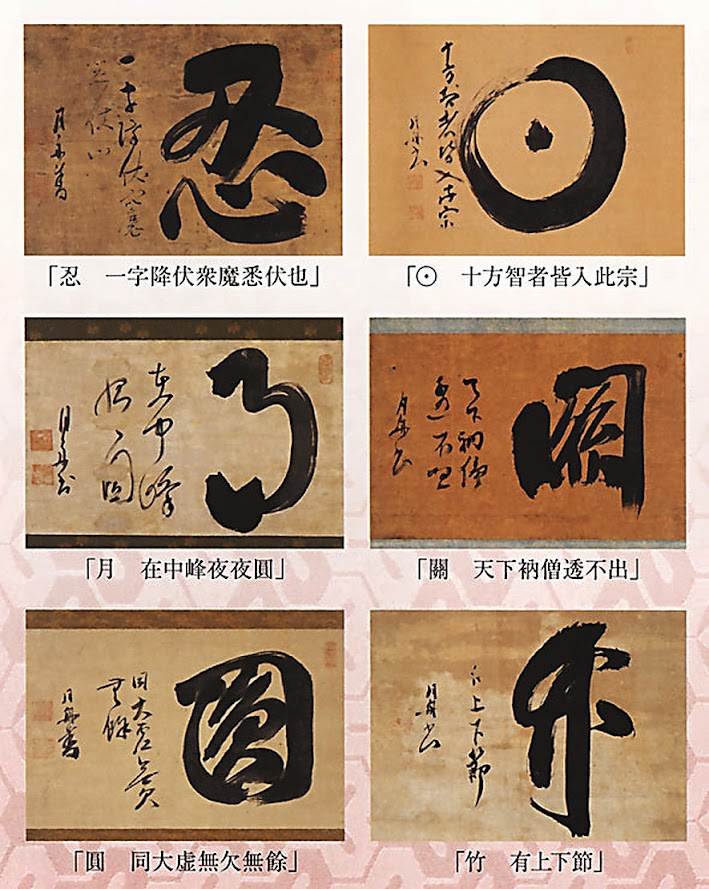
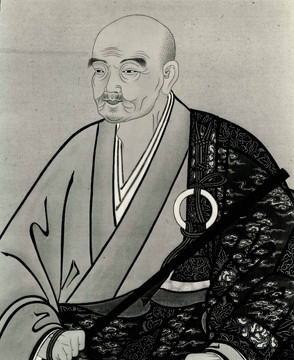
Gesshū Sōko
Búcsúverse
Fordította: Terebess Gábor
Légzés be, légzés ki
Mozgás előre, mozgás hátra
Élned, halnod, jönnöd, menned kell
Akár két nyílvessző, ha kilövi egymást
A semmiség közepén
Nyílegyenest hazaérek.
Gesshū Sōko
Meghalt 1696-ban, az első hónap 10. napján, 79 évesen.
Vers a halál mesgyéjéről
Fordította: Somogyvári Zsolt
Jisei, Farkas Lőrinc Imre Kiadó, 1994, 18. oldal
A fordítás alapjául szolgáló mű:
Yoel Hoffmann: Japanese Death Poems: Written by Zen Monks and Haiku Poets on the Verge of Death. Tuttle Publishing. 1986.
Belégzés, kilégzés
Előre, hátra
Élet, halál:
Nyílvesszők, egymáshoz fellőve
Találkoznak feleúton és átszelik
Az ürességet cél nélküli röptükben.
Így térek vissza a kezdethez.
A taoista filozófus Lie-ce (Kr. e. 4. század) írásában
említést találunk két íjász mesterről, akiknek a
nyílvesszői eltalálták egymást a levegőben. Gesshu
versében a nyílvesszők nem hullanak vissza a földre,
hanem folytatják meghatározott irány nélküli, spontán
röptüket az üres téren át. Ez a kép arra a tudatállapotra
utal, amelyben a világ szernlélésének hétköznapi módja,
koncepciói eltűnnek, és a kettősségeket (élet-halál)
felöleli a megvilágosodott létezés.
Szótó Zen mesterek versei:
Gesshū Sōko (1618-1696)
http://zen.gportal.hu/gindex.php?pg=4792614&nid=2439726
Forrás: All a Mistake: Poems of Soto Zen Masters
Translated by Yasuda Joshu roshi and Anzan Hoshin roshi
Magyar fordítás: Hadházi Zsolt
1.
Nincs mit mondhatnék
arról, ami anya
és gyerek közt van.Hallva haláláról,
életem elsötétült.Mint egy nádkosár,
az évek összefontak minket.Az üres levegőben
a füst egyetlen füstölőrúdból
utolsó szavam hozzá.(tizenhat évesen írta, zarándoklaton, hallva anyja haláláról)
2.
Hírnév és vagyon keresése
mindenkit szüntelen lefoglal,
de a nap melegében
és egy békés fuvallattal
minden természetesen új.Segítség nélkül
a tavasz ragyogása
egyszerre sápadt és mély.A hegyek
határtalan békéjében
valaki ül, egyedül.(Settsu-ben, a Takugen templomnál)
3.
A fák alatt,
üdvözölve a tavaszt.
A dolgok törődnek magukkal.Egy szerzetes furcsának tűnik
a köznépnek.Eme Újév Tanítása
nincs a tudaton kívül.Megtöltve a szemet,
kék, kék hegyek
minden irányban.
4.
Felszívva a határtalan tengert
megjeleníti a lenti sárkányt.A Szótó Zen folyama
hegynek felfele áramlik.Ébredj fel végre,
tudok lélegezni.
5.
Lélegezni be, ki,
előre, hátra,
élni, halni.Két nyíl találkozik a levegőben,
hasítva és suhanva tova
a nyílt térbe.Megfordulok.
(halálvers, 1696. január 10.)